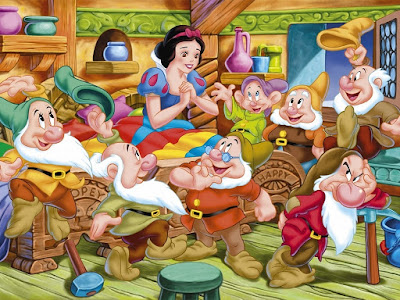One day, seven dwarven princes were walking in the forest
when they heard a woman singing so beautifully that they immediately began to
follow the sound. As they entered a clearing, they saw her: A fair maiden with
hair as dark as night and skin as white as snow, singing to a little bird that
flitted about her. The princes had fallen in love the moment they heard her
voice, and when they saw her, they immediately began to argue about which one
of them would marry her. Upon seeing them, the girl ceased her song and hurried
over. The dwarves were caught up in their argument, however, and missed the red
gleam in her eyes (for, enchanting as she was, the maiden was truly a devil,
and the bird her husband). Reaching them, she exclaimed, “Oh, please stop
arguing! I am Snow White, and I can marry all of you!”
At this, the princes stopped talking, stared up at her, and
began to smile. “That sounds great!” They chorused, and, taking her arms, led
her and the bird on her shoulder to their palace, where they lived happily ever
after.
Until the oldest brother died.
After a period of mourning, however, they lived happily ever
after.
Until the new oldest brother died.
They tried again to live happily ever after, but the
brothers continued to die, year after year, until only the youngest remained,
and even he was very ill. The princes’ subjects, worried, sought out the
huntsman, who moonlit as a fortune teller.
He didn’t actually know anything more than a few garbled phrases of real
witchcraft and the better-known divination methods, but it worked to fool the
locals, who would accept bad outcomes so long as they were predicted through
the proper channels. Still, as far as the subjects knew, he was the genuine
article, so off he went to try and cure the last remaining prince.
Upon his arrival at the prince’s bedside, the huntsman
performed a traditional prayer ceremony as he had seen other fortune tellers
do, but he only felt sick, and nothing else happened. In an attempt to continue
the charade, he shooed the others out of the room. When Snow White left the
room, his illness left with her, and that frightened him deeply. He decided to
sneak out the window, but as he leapt out to the ground, he collided with the
little bird that had come with the woman, knocking it to the ground. The
huntsman ran, but as he did, he heard Snow White go to cradle the bird in her hands,
lamenting, “Oh no! He has discovered us! Tomorrow he shall tell them to burn us
at the stake, and that will be the end!”
Though he was no fortune teller, the huntsman was no fool,
and so the next day he fetched the men who had brought him and told them the
beautiful woman and her bird were the cause of the final dwarf’s illness. The
devils were immediately burned, and the dwarven prince, Sneezy, was healed
almost immediately, though he still retained some allergies. Sniffling his was
to the huntsman, Sneezy asked how he could repay him for ending his torment, to
which the huntsman replied, “Oh, just give me some new traps and I’ll be on my
way.” And so it was done, and the huntsman and the remaining dwarf remained
friends for the rest of their lives.
Author’s note: The original story is that of The Two Devils,
which has none of the Snow White/Dwarven details. Instead, seven princes meet
this woman and her yak, who are actually a devil and her husband. All seven
brothers marry her, but afterwards one brother dies each year until only the
youngest is left, because the devil woman is eating their souls. His men fetch
a fake fortune teller, who agrees to try and heal the prince on the advice of
his greedy wife. When he gets there, he gets sick and scared and when he tries
to hide on the roof, he falls through and lands on the yak, prompting the woman
to freak out, thinking they’ve been discovered. In doing so she gives away that
the way to defeat them is to burn them alive, which the fake fortune teller proceeds
to do. The prince recovers, and the fortune teller asks for yak nose rings as
payment, which he gets, until his greedy wife demands more, and the prince ends
up giving him half of the kingdom.
In my story, I made the devil woman Snow White, the yak a
bird, and the princes dwarves. The huntsman became the fortune teller as well.
I was initially going to add the evil queen as the wife, but it didn’t seem to
fit with the story, so I left her out, which had the added benefit of letting
the huntsman accept a humble reward.
Image: Snow White and her devil bird. Source.









